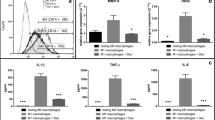Abstract
It has been reported that T cells and chondrocytes interact through cell surface molecules such as MHC, CD4 or CD8 in osteoarthritis (OA) and T cells are activated. The objective of this study is to investigate the responses of chondrocyte–T cell interaction in terms of metalloprotease (MMP) and chemokine production. Articular cartilage and autologous blood were obtained from patients with OA and fracture who under went prosthetic surgery. Synovial fluid (SF) was collected from OA patients. Isolated chondrocytes were co-cultured with autologous T cells. SF cells were analyzed by immunostaining or Alcian blue staining. The production of MMP-1, MMP-3, MMP-13, and regulated on activation, normal T expressed and secreted (RANTES) was enhanced by direct co-culture compared to indirect co-culture using Transwell. Production ratio of RANTES in OA was significantly higher than non-arthritic samples. CD3 positive mononuclear cells and chondrocyte-like cells were found in SF. Chondrocyte–T cell contact was more adhesive in OA samples. These results showed the production of MMPs and RANTES was enhanced by the interaction and that chondrocyte–T cell contact was possible in vivo.






Similar content being viewed by others
References
Pelletier JP, Martel-Pelletier J, Abramson SB (2001) Osteoarthritis, an inflammatory disease: potential implication for the selection of new therapeutic targets. Arthritis Rheum 44:1237–1247
Revell PA, Myston V, Lalor P (1988) The synovial membrane in osteoarthritis: a histological study including the characterization of the cellular infiltrate present in inflammatory osteoarthritis. Ann Rheum Dis 47:300–307
Sakkas LI, Scanzello C, Johanson N, Burkholder J, Mitra A, Salgame P, Katsetos CD, Platsoucas CD (1998) T cells and T-cell cytokine transcripts in the synovial membrane in patients with osteoarthritis. Clin Diagn Lab Immunol 5:430–437
Nakamura H, Yoshino S, Kato T, Tsuruha J, Nishioka K (1999) T-cell mediated inflammatory pathway in osteoarthritis. Osteoarthr Cartil 7:401–402
Hansen C, Otto E, Kuhlemann K, Forster G, Kahaly GJ (1996) Glycosaminoglycans in autoimmunity. Clin Exp Rheumatol 14:S59–S67
Guerassimov A, Zhang Y, Cartman A, Rosenberg LC, Esdaile J, Fitzcharles MA, Poole AR (1999) Immune responses to cartilage link protein and the G1 domain of proteoglycan aggrecan in patients with osteoarthritis. Arthritis Rheum 42:527–533
Tsuruha J, Masuko-Hongo K, Kato T, Sakata M, Nakamura H, Nishioka K (2001) Implication of cartilage intermediate layer protein in cartilage destruction in subsets of patients with osteoarthritis and rheumatoid arthritis. Arthritis Rheum 44:838–845
Yao Z, Nakamura H, Masuko-Hongo K, Suzuki-Kurokawa M, Nishioka K, Kato T (2004). Characterisation of cartilage intermediate layer protein (CILP)-induced arthropathy in mice. Ann Rheum Dis 63:252–258
Sakata M, Masuko-Hongo K, Tsuruha J, Sekine T, Nakamura H, Takigawa M, Nishioka K, Kato T (2002) YKL-39, a human cartilage-related protein, induces arthritis in mice. Clin Exp Rheumatol 20:343–350
Tsuruha J, Masuko-Hongo K, Kato T, Sakata M, Nakamura H, Sekine T, Takigawa M, Nishioka K (2002) Autoimmunity against YKL-39, a human cartilage derived protein, in patients with osteoarthritis. J Rheumatol 29:1459–1466
Lance EM, Kimura LH, Manibog CN (1993) The expression of major histocompatibility antigens on human articular chondrocytes. Clin Orthop 291:266–282
Alsalameh S, Jahn B, Krause A, Kalden JR, Burmester GR (1991) Related articles, links antigenicity and accessory cell function of human articular chondrocytes. J Rheumatol 18:414–421
Sakata M, Masuko-Hongo K, Nakamura H, Onuma H, Tsuruha JI, Aoki H, Nishioka K, Kato T (2003) Osteoarthritic articular chondrocytes stimulate autologous T cell responses in vitro. Clin Exp Rheumatol 21:704–710
Billinghurst RC, Dahlberg L, Ionescu M et al (1997) Enhanced cleavage of type II collagen by collagenases in osteoarthritic articular cartilage. J Clin Invest 99:1534–1545
Okada Y, Shinmei M, Tanaka O, Naka K, Kimura A, Nakanishi I, Bayliss MT, Iwata K, Nagase H (1992) Localization of matrix metalloproteinase 3 (stromelysin) in osteoarthritic cartilage and synovium. Lab Invest 66:680–690
Nakamura H, Shibakawa A, Tanaka M, Kato T, Nishioka K (2004) Effects of glucosamine hydrochloride on the production of prostaglandin E2, nitric oxide and metalloproteases by chondrocytes and synoviocytes in osteoarthritis. Clin Exp Rheumatol 22:293–299
Yuan GH, Masuko-Hongo K, Sakata M, Tsuruha J, Onuma H, Nakamura H, Aoki H, Kato T, Nishioka K (2001) The role of C–C chemokines and their receptors in osteoarthritis. Arthritis Rheum 44:1056–1070
Altman R, Asch E, Bloch D, Bole G, Borenstein D, Brandt K, Christy W, Cooke TD, Greenwald R, Hochberg M, Howell D, Kaplan D, Koopman W, Longley III S, Mankin H, McShane DJ, Medsger Jr T, Meenan R, Mikkelsen W, Moskowitz R, Murphy W, Rothschild B, Segal M, Sokoloff L, Wolfe F (1986) Development of criteria for the classification and reporting of osteoarthritis. Classification of osteoarthritis of the knee. Diagnostic and therapeutic criteria committee of the American rheumatism association. Arthritis Rheum 29:1039–1049
Jobanputra P, Corrigall V, Kingsley G, Panayi G (1992) Cellular responses to human chondrocytes: absence of allogeneic responses in the presence of HLA-DR and ICAM-1. Clin Exp Immunol 90:336–344
Kienzle G, Kempis J (1998) Vascular cell adhesion molecule 1 (CD106) on primary human articular chondrocytes. Arthritis Rheum 41:1296–1305
Horner A, Davies ME, Franz B (1995) Chondrocyte-peripheral blood mononuclear cell interactions: the role of ICAM-1. Immunol 86:584–590
Ashman RF (1994) Turek’s orthopaedics, principles and their application, 5th edn. In: Ryan JD (ed) Lippincott Co., Philadephia, pp 152–155
Hashimoto S, Ochs RL, Komiya S, Lotz M (1998) Linkage of chondrocyte apoptosis and cartilage degradation in human osteoarthritis. Arthritis Rheum 41:1632–1638
Acknowledgement
This study is partly supported by the Japanese Ministry of Education, Culture, Sports, Science and Technology.
Author information
Authors and Affiliations
Corresponding author
Rights and permissions
About this article
Cite this article
Nakamura, H., Tanaka, M., Masuko-Hongo, K. et al. Enhanced production of MMP-1, MMP-3, MMP-13, and RANTES by interaction of chondrocytes with autologous T cells. Rheumatol Int 26, 984–990 (2006). https://doi.org/10.1007/s00296-006-0116-5
Received:
Accepted:
Published:
Issue Date:
DOI: https://doi.org/10.1007/s00296-006-0116-5




